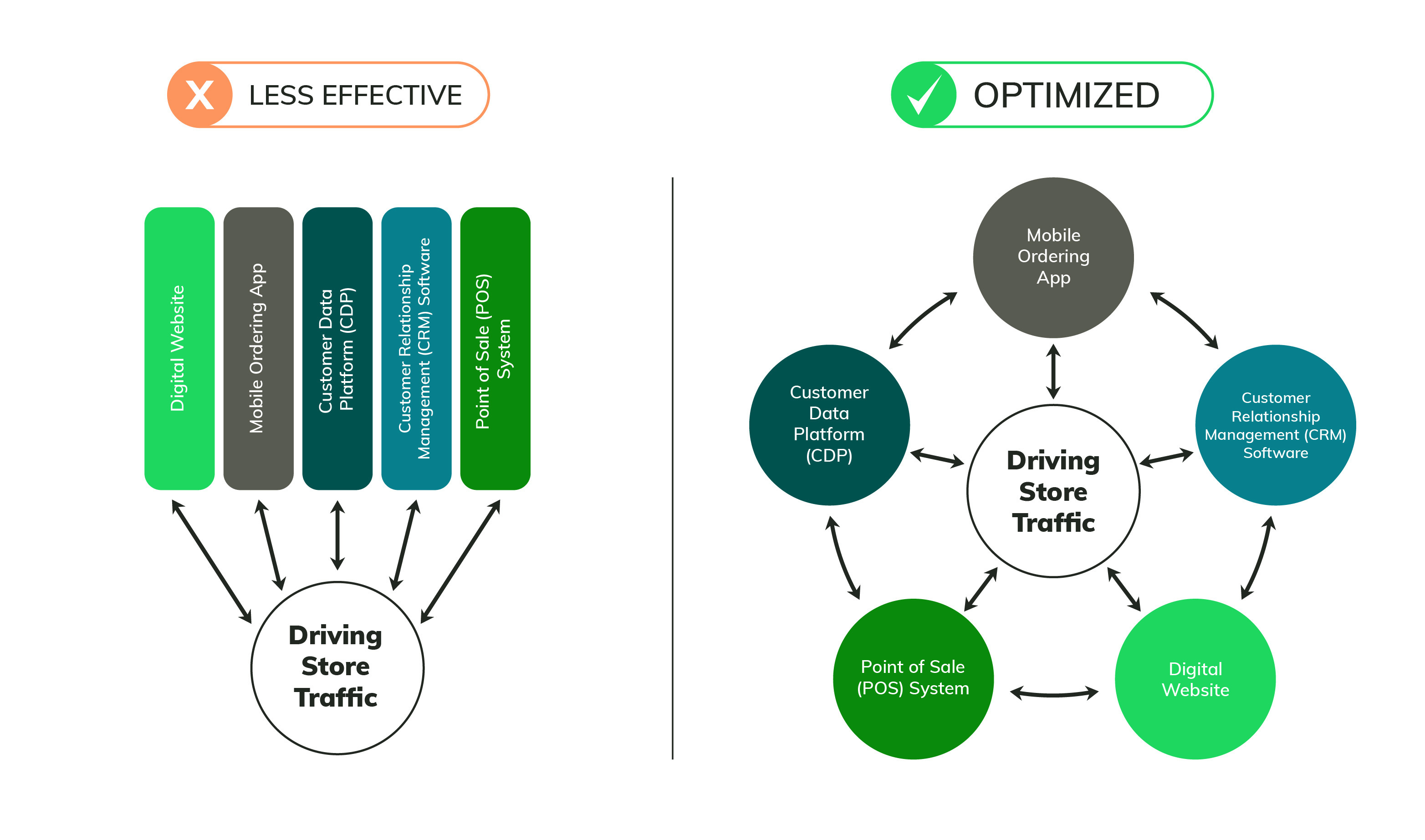Delivering a personalized customer experience is no longer an advantage for restaurant chains—it’s expected. Restaurant brand marketers often find themselves navigating a complex maze of data from complementary, but unintegrated, technologies. Further complicating the landscape, there are different partners for loyalty programs, mobile apps, point-of-sale systems, and CRMs.
As a result, brands are left with siloed and fragmented ecosystems that hinder their ability to build a cohesive customer view, making personalization more of a challenge for marketers than it needs to be.
The good news is, there are ways to simplify and improve this process. By taking a step back to assess current MarTech infrastructure, restaurant marketers can better understand how their tools and platforms contribute—or fail to contribute—to a holistic data strategy. This transformation calls for a focus on three critical elements: people, process, and technology.
Below we explore critical steps to building a connected ecosystem that enables restaurant chains to transform data into actionable insights and offer guests greater value by delivering a more cohesive and consistent personalized experience.
Slow Down to Speed Up
It is important to hit the brakes, do some homework, and gather the foundational intel necessary to address issues effectively, allowing for more efficiency in the long run. Before diving into solutions, brands need to be clear on their goals and understand how their tech strategy helps them efficiently achieve those goals.
When working with multiple technology vendors and partners, it’s critical to understand the root of your data silos and which systems are or are not working together. The reality is that most issues stem from the ecosystem in which the technologies live and operate—not the technology itself.
An experienced agency partner can help brands get a clear view of redundancies or gaps in their stack, and determine opportunities to streamline processes.
For example, a common issue QSR brands face is duplication of customer data. This issue arises when new customer records are created each time an existing customer engages in a new way, for instance, via the mobile app, the drive-thru, and in-store using an FSI, and the original profile is not updated. In fact, research shows that duplication rates between 10% and 30% are not uncommon for companies lacking data quality initiatives (HubSpot).
This was the case for a leading QSR brand who sought MERGE’s expertise to help navigate this issue and understand how to both reduce duplicate records and unify their data.
We conducted an in-depth evaluation and produced a detailed report card that identified recommended partners for a Customer Data Program (CDP) to streamline their data processes. After the client selected the recommended partner, MERGE provided consultative support throughout the implementation, guiding them through the end-to-end process from problem identification to the go-live. With this strategic guidance, the client was able to reduce their duplicate records to one-eighth of the original count.
More often than not, technology is part of the solution, but it’s not the solution. By taking the time to understand where silos occur and the inefficiencies that arise, brands can start to simplify their stack and create a more customer-centric ecosystem.
Efficiency Blueprint: The Hub-and-Spoke Model
To move from a siloed ecosystem to one that is connected and unified, QSR brands should aim to adopt a “hub and spoke” model.
Here, each application or tool operates as a spoke connected to a central hub, organizing and distributing data to form a cohesive network that ensures accurate data flow across touchpoints.

Most importantly, the hub-and-spoke model exposes two main advantages—a unified data strategy and additional ways to personalize customer experience. Data signals and pathways are often more complicated than what a single source of interaction provides.
By consolidating them, brands can move closer to a single source of truth for its consumers. It’s the same way unique personalization opportunities arise when the same shoppers move between different marketing channels.
Aligning People, Processes, and Technology
Transitioning from a siloed ecosystem to one that is interconnected and unified requires a focus on not only technology, but also people and process.
With cross-functional teams like marketing, IT, and operations often working in silos, this alignment is vital for consolidating data, and in turn, creating more informed, nimble, and efficient operations to enable teams in their pursuit of personalized 1:1 connections with consumers.
This process requires a thorough evaluation of current practices, roles, and systems. Below is a list of guiding questions to help marketing leaders navigate this transition:
People:
- Do we have the necessary skills, knowledge, and experience for this project?
- Have these skills and experiences been clearly identified and communicated?
- Are we committed to training and development?
Process:
- What is the timeline for implementing this process?
- Has the process been clearly defined?
- What does success look like for this project?
- How will training and implementation be conducted, and how will feedback be captured?
Technology:
- Does this product align with our business strategy?
- Is the implementation making it easier for our employees?
- What are the KPIs we are measuring to prove effectiveness?

Despite the inherent complexities and challenges that come with managing data and technology, the value of delivering personalized experiences remains unparalleled. Effective system integration helps create operational alignment, and ultimately, the delivery of consistent customer experiences, whether online or in-store.
A Look Ahead
Having a deep knowledge and understanding of core customers is ultimately how restaurant bands can unlock value. To make this a reality, brands must simplify with a connected ecosystem that works with them—not against them. At the core, this requires having the right people in place, with the right processes implemented, and the right technology integrated.
For a comprehensive technological assessment, connect with our team today to optimize your tech ecosystem to drive traffic and transactions.


